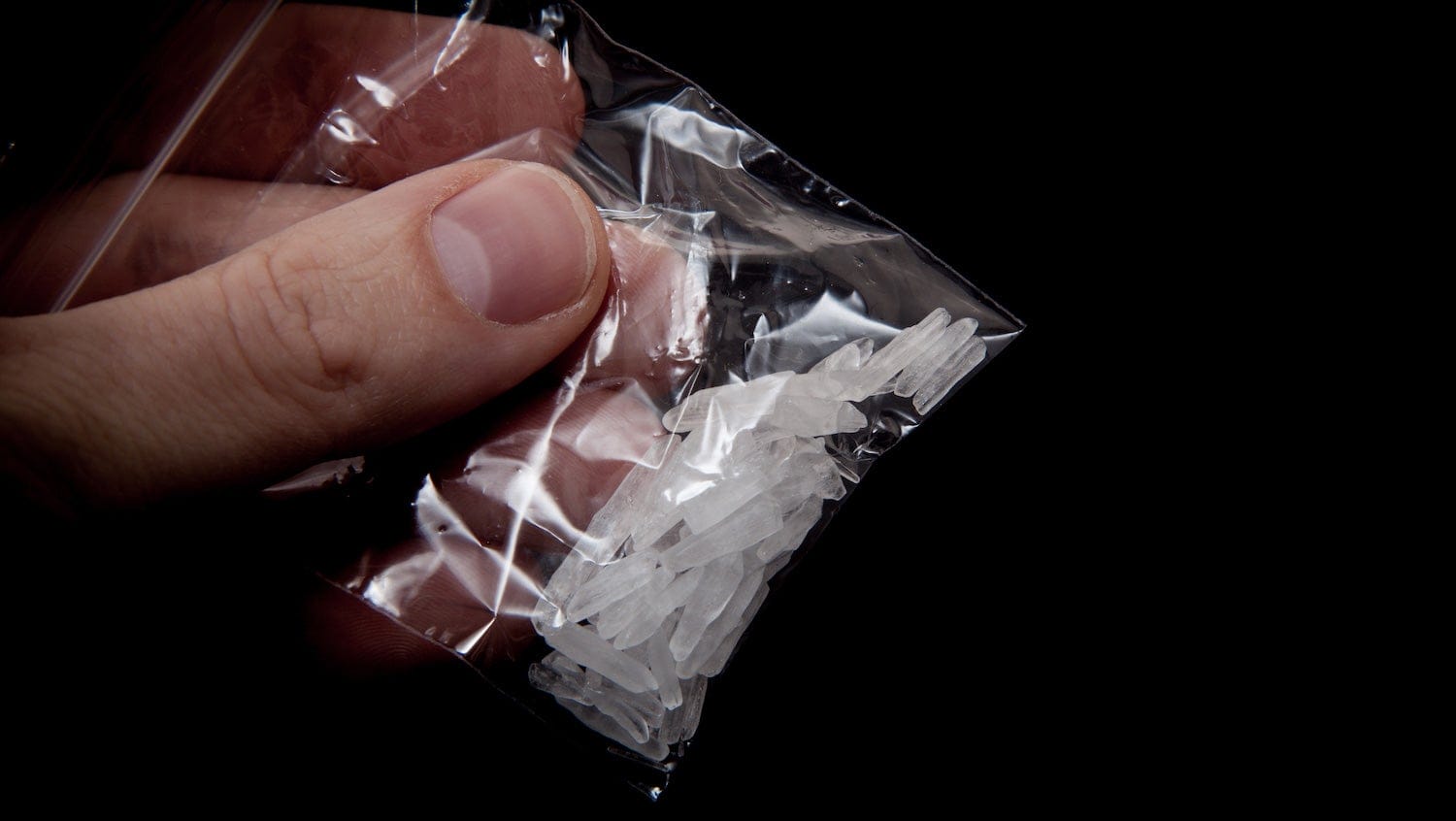‘Meth Is Here and Now’: A Growing Presence in the Opioid Crisis
September 27, 2019

Getty Images
An HIV and addiction expert shares his insights into the evolving presence of methamphetamine in the opioid crisis and its implications for curbing substance use disorder.
Addiction specialists are pointing to polysubstance use — the practice of mixing opioids with cocaine, benzodiazepines, and, increasingly, methamphetamine — as the latest complication of the opioid epidemic that adds a new layer of concern to an already fraught, national issue.
Historically recognized as a problem concentrated in rural areas of the western and midwestern U.S., methamphetamine has begun creeping into drug markets along East Coast cities, with rising rates reported everywhere from Massachusetts to North Carolina. Health professionals across the country are now struggling to thwart the spikes in methamphetamine use, while public health officials and law enforcement attempt to understand where the influx of meth is coming from.
Justin Alves, a registered nurse, has spent years on the front lines of addiction and HIV care. His career has taken him across the state of Massachusetts, from volunteering at the Needle Exchange in Cambridge to traveling in a mobile van clinic delivering free HIV and STI testing. Earlier this year, Alves joined the staff of the Office-Based Addiction Treatment Training and Technical Assistance (OBAT TTA) program at Boston Medical Center as an addiction educator, a role in which he provides training and other technical assistance to healthcare providers across the state.
Alves recently spoke with HealthCity, offering his insights into the evolving presence of methamphetamine in the opioid crisis and its implications for curbing substance use disorder.
HealthCity: How has methamphetamine use disorder changed over the course of your career?
Justin Alves: In 2009 and 2010, I had maybe two patients who used meth. Meth was largely used in the chem sex community, where men who have sex with men are having sex and using drugs — and not just meth. It’s also GHB, ketamine, amyl nitrates, illicit Viagra and Cialis and Trimix. It’s a very hypersexualized scene that has been in the Northeast for a long time.
And recently, within the last year or year-and-a-half, we’ve seen methamphetamine use creeping outside of a very localized community. I liken it to HIV. It started in this very closed network, and it has slowly started to make its way into other injection drug user networks.
The tip off to me that meth was coming was a little HIV breakout in Lawrence and Lowell, 160 new cases. This is something we had seen in Indiana with opioids. I was still working on the van and going up there to see what people were using, and it became very obvious there was a methamphetamine component to it.
HC: How has the rise of methamphetamine use changed the opioid crisis locally?
JA: Meth is the neglected stepchild of the opioid epidemic. When you look at state and CDC data on overdoses involving amphetamines or stimulants, they have grown exponentially. And the reason for that is we don’t have good treatment for stimulant use disorder, and the current system that we have is not set up to take care of these patients.
HC: What about methamphetamine use or addiction makes it so difficult to manage?
JA: One is that there’s no FDA-approved drug to treat it. We’ve had lots of trials and they’ve all failed miserably.
All substance use disorders are traumatic, but meth, far and away, is the most traumatizing of all the drugs someone can do. There is this hypersexuality that happens, and so sexual assault is rampant among people who use meth.
The other piece that’s super traumatizing is the psychosis that’s involved with methamphetamine, which is terrible. In about 10–25% cases, it persists post-withdrawal. The drug itself induces a psychosis and a disinhibition unlike what we see with other drugs. It’s stronger than crack, it’s stronger than cocaine, it’s really pushing the envelope in what is normal. It increases dopamine in the brain by upwards of 4,000 times what is normal, so even only using a few times, most folks could develop a use disorder.
HC: How do those symptoms present in a clinical space?
JA: When you go into a setting where you know there is a lot of meth use, you can just tell, because the behaviors are different. And those behaviors exhibit in the waiting room, too: they’re talking to themselves, they’re hearing things, they’re extremely agitated. Patients might be floridly psychotic. Folks can’t sit down, they can’t wait for an appointment.
The persecutory, paranoid psychosis puts you in this heightened fight or flight response — and if you feel like you can’t flee, you feel like you have to fight. The aggression we see is a product or symptom of someone’s meth use, and it needs to be factored in to how we approach their behavior. While we have these great clinics for opioid use disorder, they’re not adequately set up to take care of a patient who is in an acute meth psychosis or who hasn’t slept in six days.
HC: What would we need in order to treat patients with meth use disorder properly, then?
JA: The mainstays of treatment we have now are cognitive behavioral therapy, contingency management, and motivational interviewing. Unfortunately, they are not super effective.
In my beautiful world, there would be more of what’s called Sobering Centers. These are alternatives to the emergency room, with highly skilled addiction nurses who have some med surg experience. They could take not just patients with methamphetamine use disorder, but also patients who are acutely intoxicated from alcohol, and those who might have recently had an overdose from opioids. They keep them, they treat them during their acute intoxication, and then they offer them treatment beyond.
People have focused on safe consumption sites, which I’m not opposed to either, but that mitigates one problem. When we talk about all substance use disorders and creating a safe space for everybody, I think Sobering Centers would be a really novel way to do it.
HC: Treatment is an important part of the equation. What opportunities do we have for prevention?
JA: Substance use disorders as a whole are driven by adverse childhood events, trauma, and environmental things.
We’ve gotten really, really good, in Massachusetts in particular, about rolling out medications for opioid use disorder — but that’s treating just one problem. It’s preventing them from overdosing on opioids, but it’s not fixing the underlying social determinants of health that drive their substance use disorder.
Meth is the happy drug. It’s this escape from reality — that’s really the crux of the issue. And so trying to intervene and ask, “How do I get you to a place where every single day you don’t hate your life?” is important, because that’s most of what it is. If we really want to see dramatic changes and end addiction long term, we need to start talking about what those underlying determinants of health are — the homelessness, the traumas, the mental illness. It’s all these things that compound.
HC: Part of your role is provider education. How does more widespread understanding help the medical community with successful intervention techniques?
JA: One of the things that I do recognize as being the most helpful in my work has been early intervention. But where folks choose to access care is not in addiction settings. They go to the STD clinic or elsewhere. So it’s about retraining some of our colleagues to say, “Can we recognize this?” Imagine, if the first time someone said they tried meth, the provider said, “Okay, well let’s talk about that. You now need to be on pre-exposure prophylactics because we know people who use meth have a high likelihood to get HIV. We know there’s a high percentage of people who get Hep C. We know that these things are going to induce psychosis. Why did you try meth, what was the underlying motivation?”
It’s getting people to think about meth as a drug that could happen — it’s not just something that’s in Ohio, it’s something that’s here and now. We need to be asking about it, and really getting ahead of this before we are chasing it like we are with opioids.
This interview has been edited and condensed.


